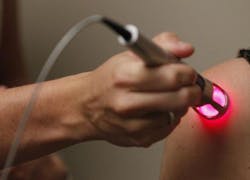Back in 2009, my article entitled "Low-level light therapy: It's all about wavelength and power" described how lasers are being used in the treatment of such bodily pains as carpal tunnel syndrome, sports injuries, and arthritis. Four years later, more and more therapy clinics are offering laser treatments and many laser products are garnering international and FDA approval for pain treatment.
For example, The Gazette (Cedar Rapids, IA) reported in July 2013 that the K-Laser class 4 therapeutic laser from K-LaserUSA—which uses four wavelengths of light (three infrared, one visible red) and received FDA approval in 2012—increases circulation and brings oxygen and nutrients to stimulate cell function to reduce inflammation, decrease pain, and increase healing time for damaged muscles. The image below shows a chiropractor demonstrating the K-Laser on a member of the office staff who uses the laser treatments on her shoulder to treat pain from exercising:But just how effective are these clinical therapies? A detailed look at numerous clinical trials indicates that not all laser therapies are beneficial. A compilation of clinical studies from insurance company Aetna (Hartford, CT) concludes, "Although the results from large, uncontrolled, open trials of low-energy lasers in inducing wound healing have shown benefit, controlled trials have shown little or no benefit." The study looks at healing lasers in two categories: low-energy and high-energy lasers. Low-energy lasers (also known as cold lasers or class III lasers) induce minimal temperature elevation (not more than 0.1 to 0.5°C) and have treatment energies of a few J/cm2 and laser powers of 500 mW or less. Typical low-energy lasers used in these trials included 637, 809, and 904 nm lasers with output powers of around 50 mW. High-energy lasers (class IV therapeutic lasers) have power levels of up to 7500 mW, can penetrate up to 10 cm2 instead of 0.5 to 2.0 cm2 for class III lasers, and have a larger surface treatment area (cover up to 77 cm2 instead of 0.3 to 5.0 cm2 for class III lasers). Unfortunately, most of the studies cited were for low-energy lasers and high-energy lasers were not adequately represented.
So how do high-energy lasers fare in clinical studies? A Canadian study using a class IV, 10 W, dual-wavelength 810/980 nm laser to treat patients with epicondylitis (tennis elbow) via eight treatments at roughly 6.6 J/cm2 laser power levels showed increased handgrip strength and pain reduction, with the study concluding "... that laser therapy using the 10 W class IV instrument is efficacious for the long-term relief of the symptoms associated with chronic epicondylitis." Still another study of patients with myofascial neck pain specifically treated with high-power lasers concludes, "Class IV laser therapy showed a majority of patients who underwent treatment reported improvement, as assessed by VAS, Global impression, and MPDD trigger points detection." While I don't pretend to understand what VAS and MPDD mean, I do find that numerous clinical trials favor high-energy laser therapy while low-level light therapy (LLLT) results are mixed and inconclusive.
If you search YouTube using the words "class IV laser therapy", you can find a host of great videos describing the technology for both humans and animals, as well as understand how important proper laser use is to prevent tissue damage. I loved seeing how mobility improved for this arthritic penguin after class IV laser treatments:
Today, I'm encouraged that clinicians who continue to explore laser therapy will eventually find the right laser parameters to treat a variety of conditions. That being said, the latter part of the title of my 2009 article is still accurate: "It's all about wavelength and power."


